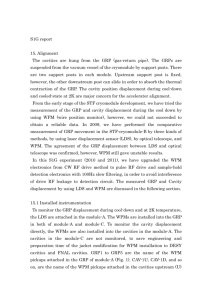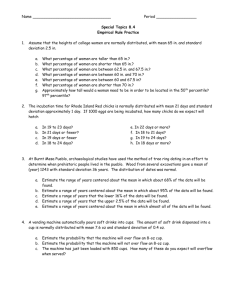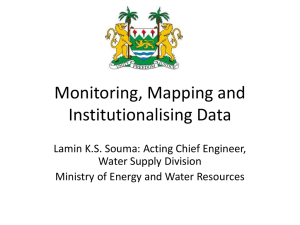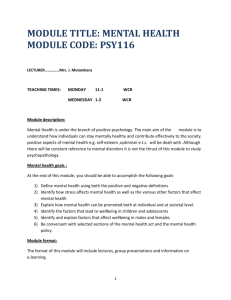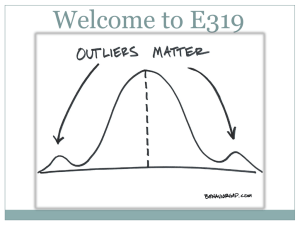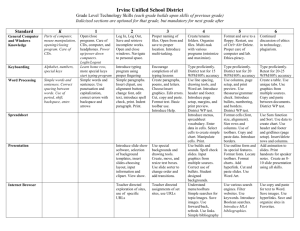Draft
advertisement
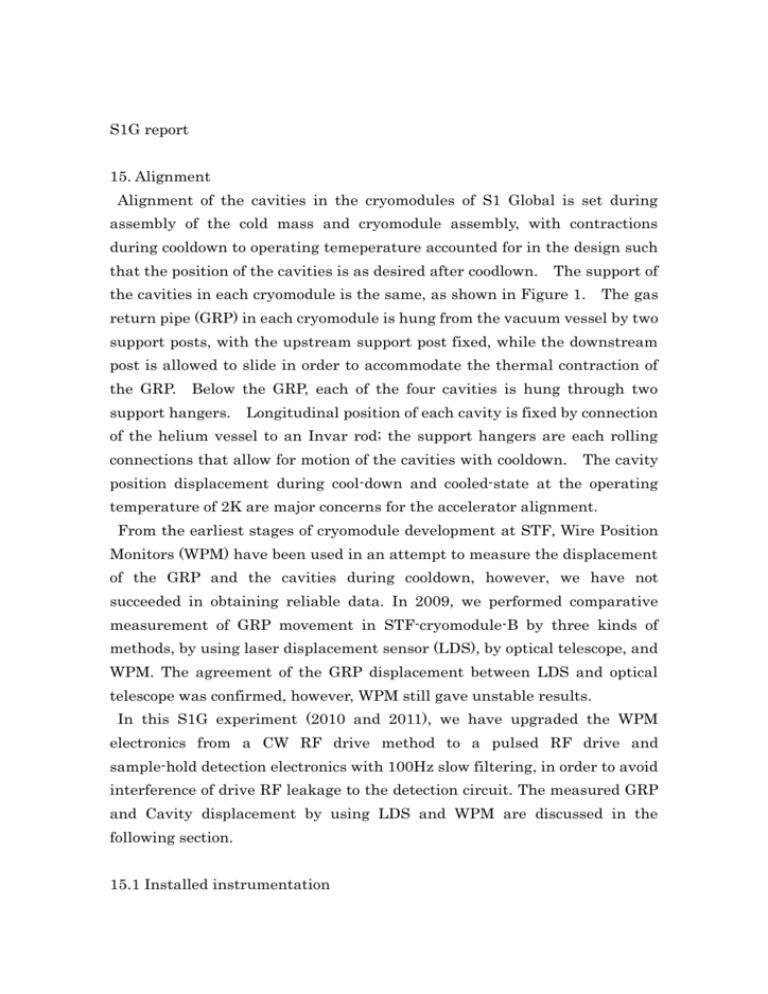
S1G report 15. Alignment Alignment of the cavities in the cryomodules of S1 Global is set during assembly of the cold mass and cryomodule assembly, with contractions during cooldown to operating temeperature accounted for in the design such that the position of the cavities is as desired after coodlown. The support of the cavities in each cryomodule is the same, as shown in Figure 1. The gas return pipe (GRP) in each cryomodule is hung from the vacuum vessel by two support posts, with the upstream support post fixed, while the downstream post is allowed to slide in order to accommodate the thermal contraction of the GRP. Below the GRP, each of the four cavities is hung through two support hangers. Longitudinal position of each cavity is fixed by connection of the helium vessel to an Invar rod; the support hangers are each rolling connections that allow for motion of the cavities with cooldown. The cavity position displacement during cool-down and cooled-state at the operating temperature of 2K are major concerns for the accelerator alignment. From the earliest stages of cryomodule development at STF, Wire Position Monitors (WPM) have been used in an attempt to measure the displacement of the GRP and the cavities during cooldown, however, we have not succeeded in obtaining reliable data. In 2009, we performed comparative measurement of GRP movement in STF-cryomodule-B by three kinds of methods, by using laser displacement sensor (LDS), by optical telescope, and WPM. The agreement of the GRP displacement between LDS and optical telescope was confirmed, however, WPM still gave unstable results. In this S1G experiment (2010 and 2011), we have upgraded the WPM electronics from a CW RF drive method to a pulsed RF drive and sample-hold detection electronics with 100Hz slow filtering, in order to avoid interference of drive RF leakage to the detection circuit. The measured GRP and Cavity displacement by using LDS and WPM are discussed in the following section. 15.1 Installed instrumentation After the experience of STF cryomodule B, a more extensive instrumentation plan was created to to monitor the GRP displacement in both modules of S1 Global during cool-down and when the system is in equilibrium at 2K. The position of the GRP of module A was measured using both LDS and WPM. In addition, the cavity displacements were also monitored directly using a WPM system in module A. In module C, the position of the GRP was measured by WPM as in module A, but no LDS system was installed nor were the cavities in module-C were monitored, to save engineering effort and the preparation time for the jacket modifications that would be required to the DESY and FNAL cavities. GRP1 to GRP5 are the name of the WPM pickups attached in the GRP of module-A, while LDS1 through LDS4 are the (Fig. 1). CAV-1U, CAV-1D, and so on, are the names of the WPM pickups attached to the upstream (U) and downstream (D) ends of each cavity of module-A (see Fig. 1, also). Fig. 1 Installed displacement monitors in Module-A. LDS1-4 are the laser displacement sensors, GRP1-5 are the wire position monitors on the GRP, and GRP-1-5 and CAV-1U -4D are the wire position monitors on the cavity jackets. 15.2 Laser position monitor (LDS) Four laser displacement sensors, LDS1, LDS2, LDS3, and LDS4, are installed in the top of the module-A vacuum vessel (Fig. 1). There are 4 glass windows to allow laser light to reach a mirror mounted on the GRP and reflect back to the sensor. Keyence LK-G sensors are used as shown in Fig.2. The specifications are as follows; measuring range: 400±100 mm resolution: 2 µm linearity: ± 0.05 % of F.S. laser spot diameter: approx. 290 µm. Fig. 2 LDS (Laser displacement sensor) 15.3 Wire position monitor (WPM) The two stretched wires of 70µm diameter gold-plated tungsten are used in S1 Global, one to monitor the displacement of the GRP and another the displacement of the module A cavities. The wires are stretched the 12m distance through the module-C and module-A. In module C, at the upstream end of each wire is an N-type feed-through connector for feeding the RF pulse into the wire. At the other end, the wires are electrically insulated with no resistor, and a SUS weight of 500g is hung to provide tension in the wire. The aluminum pipe shields are inter-connected between WPM pickups and thin SUS pipe for endplates. Each WPM pickup (Fig. 3) consists of 4 strip-lines (SUS electrodes) and an aluminum body with SMA connectors, where one end is terminated by a 50-ohm resistor and the other is connected to the signal cable. The drive RF pulse is a burst sine-wave signal of 160MHz with 100ns pulse width, +23dB in amplitude. The mV-level signal from the pickup electrodes are multiplexed and amplified by a log-amplifier and amplitude-detected, then converted to DC voltage by a sample hold circuit. The detected DC voltages are routed into a 16bit ADC, and sent to the data logging computer. The time interval of the WPM recording is around 10 seconds. The resolution of the system is on the order of 10µm, with the error of position detection estimated to be less than 5%. Fig. 4 shows the position of the installed WPM in the cross-sectional view of the cryomodule. Fig. 3 Drawings and picture of WPM pickup. (a) GRP-WPM installation position (b) Cavity-WPM installation position Fig. 4 WPM position in the cryomodule cross-section 15.4 Position displacement measurement for GRP and Cavities Cooling down from room temperature to ~150K was done by He gas (~80K), with mass flow rate of ~1.5 g/sec. From 150K to 2K, cooldown was completed using liquid He with mass flow rate of ~0.35 g/s. The liquid He consumption at cold state of 2K was about 0.4 g/s. For the duration of the test due to administrative limits the STF cryogenic system was operated only between xxAM and yyPM four days of each week, with no operation overnight and on the weekend (intermittent cooling). Representative displacement data presented here for the alignment discussion was selected from the period between January 19, 2011 to March 9, 2011. During this period the WPM electronics was in its most stable and upgraded state. The temperature variation of GRP and helium vessel in this term are shown in Fig. 5 (a), including the cool-down and warm-up periods at the beginning and end, bracketing 4 full weeks of daily operation and weekend warmups.. Overall data of WPM in GRP are shown in Fig. 5 (b) and (c). They show X position shift and Y position shift of GRP during cool-down and at 2K state. (a) Temperature change during Jan. 2011 to Mar. 2011 experiment (b) Y position change of GRP by WPM during Jan. 2011 to Mar. 2011 exp. (c) X position change of GRP as measured by WPM during Jan. 2011 to Mar. 2011 exp. Fig. 5 GRP-WPM signal overview during Jan. 2011 to Mar. 2011 exp. During cool down, large displacements of the GRP in the Y direction (max 2.7 mm) are observed as shown in Fig. 6 (a), (b), (c), and (d). However, the measurements at 2 K obtained from WPM-GRP Y positions are not consistent with the Y positions of LDS, or with the estimated displacement (dY = - 0.22 mm). Displacements of -GRP in the Y direction at 2K as measured by the WPM are hard to understand. The behavior of WPM-GRP X position during whole period seems to be reasonable, however, the amount of displacement at 2 K, around +0.4mm, is much smaller than the estimated value (+0.62 mm). The behavior of WPM-GRP-1 X position is different from other WPM-GRP X positions. The displacements measured by the WPM mounted on the cavities in the Y direction at 2K can be separated into two groups. The first group of measurements are around -0.5mm, the other is -1mm. The estimated value (-1.07 mm) is consistent to the second group, but the first clsuter is hard to understand. The behavior of Cavity-GRP X positions are roughly consistent with the estimated value, +0.75mm. However, there are 0.4 mm variations in these measurements. WPM-Cavity-2 UY and WPM-Cavity-4 UY were omitted because of unstable data, and WPM-Cavity-1 DY and WPM-Cavity-3 UX were interchanged because of miss-connection. (a) GRP Y position change during cool-down (b) GRP X position change during cool-down (c) Cavity Y position change during cool-down (d) Cavity X position change during cool-down Fig. 6 Displacement measured by WPM and LDS during cool-down period During the periods of 7 Feb to 11 Feb. and 15 Feb. to 19 Feb., module-A was kept at 2 K in the daytime. Fig. 7 shows WPM and LDS variations as a a function of the 2K temperature. The fluctuation widths of the LDS signals during the periods are about 0.2 mm, however, those of the WPM-GRP Y position are smaller than 0.1 mm. The fluctuation widths of the WPM-Cavity are also smaller than 0.1 mm. The reason of this difference between LDS stability and WPM stability is not yet understood. (a) GRP Y position change during cooled-state (b) GRP X position change during cooled-state (c) Cavity Y position change during cooled-state (d) Cavity X position change during cooled-state (e) GRP temperature change during cooled-state Fig. 7 Displacement measured by WPM and LD during cooled-state Summary (1) During the cool down, rather large vertical displacement (max 2.7 mm) at the ends of GRP were recorded by both the LDS and WPM. (2) The GRP displacement measured by WPM is roughly 1.4 times larger than that of LDS. (3) After the cavities are cooled to 2 K, the fluctuation of GRP position measured by WPM is less than 0.1 mm, while the fluctuation of measured by the LDS is about 0.2 mm. The reason for this LDS-WPM discrepancy is not clear yet. However, it seems that WPM pickups need to be modified to have more stable thermal contraction by this big thermal excursion. Also we found that some of the SMA connectors of the signal cables were unstable during this thermal excursion. These should need to be upgraded in the next installation.
